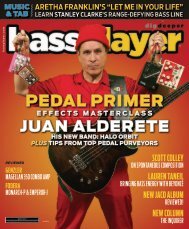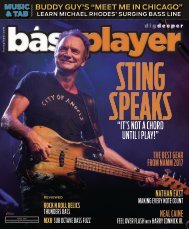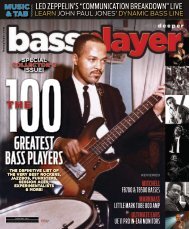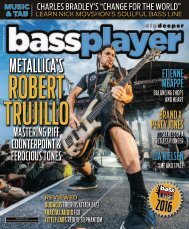BassPlayer 2017-03
BassPlayer 2017-03
BassPlayer 2017-03
Create successful ePaper yourself
Turn your PDF publications into a flip-book with our unique Google optimized e-Paper software.
CS<br />
Oskar Cartaya<br />
led to my producing Two Amigos for GRP in 1990, with [flautists] Dave Valentin<br />
and Herbie Mann.<br />
What brought you back to Los Angeles, where you’ve remained ever since?<br />
A relationship I was in ended, so in late 1993 I came to L.A. just for the weekend,<br />
but when I called friends, they had gigs and sessions for me. My car sat at<br />
JFK for three months. Even the Northridge earthquake didn’t dissuade me! I<br />
went back to New York and got my stuff and moved to L.A. in early 1994. Soon<br />
after, Herb Alpert called me to write and produce his Passion Dance album, and<br />
I’ve had the tremendous good fortune to remain busy to this day.<br />
How have your roots in Latin bass impacted your overall style, and<br />
what insight can you share?<br />
I think of the instrument as a melodic drum, which is the traditional concept.<br />
In Latin bass, your rhythmic sensibility comes first. That’s primarily how<br />
you create a push-and-pull tension in the music, although you can accomplish<br />
it melodically, too. When I play other styles, I may draw from that knowledge<br />
and move something over by an eighth-note, and the band will react. That’s no<br />
different from an Anthony Jackson or Charlie Haden bringing their R&B or jazz<br />
knowledge to the Latin gigs they’ve done, contributing something new to the<br />
genre in the process. But I’ve worked hard to learn other styles authentically,<br />
as well. My list of credits proves I can play bass in any language, and that’s what<br />
all bassists should strive for.<br />
Victor Wooten AD 17.qxp_Layout 1 1/18/17 I do 11:28 have a AM tip Page I like to 1 share when I’m asked how to play bass in a Latin<br />
rhythm section, where so much is going on: Think of all the percussion<br />
instruments as part of an elaborate drum kit—<br />
the congas are the bass drum, the timbales can<br />
be the hi-hat, the bongo cowbell the snare, and so<br />
on. In other words, listen to and play to the overall<br />
groove as a whole, just as you play to a drum kit<br />
without consciously breaking down and following<br />
each part of the kit individually.<br />
Any other thoughts or words of advice?<br />
I’ve always taken immense pride in my heritage<br />
and in helping to set a precedent for others with<br />
similar backgrounds to follow. I can remember sitting<br />
on my porch as a kid and playing along with<br />
records by artists whom I would eventually get to<br />
work with. I’d like any young bassist in any rural town<br />
anywhere in the world to know that you can do it,<br />
too. Limitations only come from within, so dream<br />
big. In everyone’s career, luck and talent will meet<br />
at some point. The key is to be as prepared as possible<br />
on the talent side so you can take advantage<br />
when that moment of luck and opportunity arrives.<br />
Having this album project come together, I feel like<br />
I’m entering another period of good fortune, and<br />
I’m going to make the most of it. BP<br />
Berklee Summer Programs:<br />
VICTOR WOOTEN BASS WORKSHOP<br />
Friday, June 16–Sunday, June 18, <strong>2017</strong><br />
Victor Wooten, a bass virtuoso who has won five Grammys, and renowned longtime<br />
collaborator Steve Bailey, Bass Department chair at Berklee College of Music, will help<br />
you make your bass lines groove like never before as you learn cutting-edge concepts<br />
from Berklee and the Victor Wooten Center for Music and Nature.<br />
berklee.edu/summer






